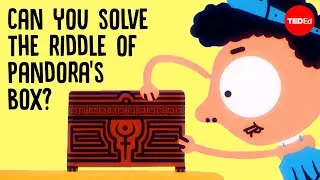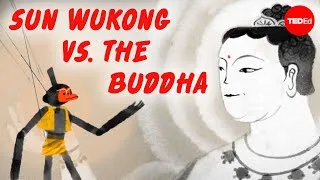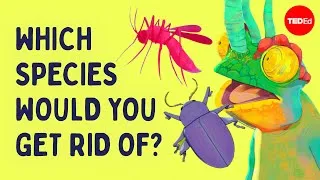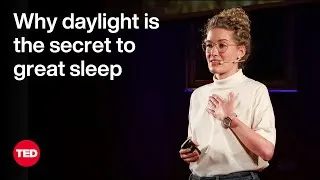The last banana: A thought experiment in probability - Leonardo Barichello
最後的香蕉:機率實驗 - 李奧那多.貝里伽
1,670,176 views ・ 2015-02-23
請雙擊下方英文字幕播放視頻。
譯者: Greg Hsiao
審譯者: 呈政 顏
00:06
You and a fellow castaway
are stranded on a desert island
0
6412
4146
你和你的同伴流落荒島
00:10
playing dice for the last banana.
1
10558
3052
玩骰子決定誰拿走最後一根香蕉
00:13
You've agreed on these rules:
2
13610
1994
你們都同意這些規則
00:15
You'll roll two dice,
3
15604
1542
你們將擲兩個骰子
00:17
and if the biggest number
is one, two, three or four,
4
17146
3923
如果最大的數字是
1到4
00:21
player one wins.
5
21069
2284
第一名玩家獲勝
00:23
If the biggest number is five or six,
player two wins.
6
23353
4973
如果最大的數定提5 或6
第二名玩家獲勝
00:28
Let's try twice more.
7
28326
1828
咱們多試兩次
00:30
Here, player one wins,
8
30154
3093
這裡,第一名玩家獲勝
00:33
and here it's player two.
9
33247
2724
而這裡,則是第二名玩家獲勝
00:35
So who do you want to be?
10
35971
1770
那你想當哪一個玩家呢?
00:37
At first glance, it may seem
like player one has the advantage
11
37741
4466
第一印象,
似乎是第一名玩家佔優勢
00:42
since she'll win if any one
of four numbers is the highest,
12
42207
4015
因為如果四個數字的任一個為最大,她將獲勝
00:46
but actually,
13
46222
1014
但,事實上
00:47
player two has an approximately
56% chance of winning each match.
14
47236
6383
第二名玩家有56%的機率會獲勝
00:53
One way to see that is to list all
the possible combinations you could get
15
53619
3908
用一種方法,來看看你所能得到的所有組合
00:57
by rolling two dice,
16
57527
2000
從擲兩個骰子的活動中
00:59
and then count up
the ones that each player wins.
17
59527
3147
然後計算每個玩家獲勝的次數
01:02
These are the possibilities
for the yellow die.
18
62674
2634
這些是黃骰子可能的結果
01:05
These are the possibilities
for the blue die.
19
65308
2476
這些是藍骰子可能的結果
01:07
Each cell in the chart shows a possible
combination when you roll both dice.
20
67784
5430
表中的每個格子
代表擲兩個骰子的可能組合
01:13
If you roll a four and then a five,
21
73214
2055
若你擲出一個4 和一個5
01:15
we'll mark a player two
victory in this cell.
22
75269
2176
我們就註記第二名玩家
在這格獲勝
01:17
A three and a one gives
player one a victory here.
23
77445
5051
一個3 和一個1
代表第一名玩家獲勝
01:22
There are 36 possible combinations,
24
82496
2321
總共有36種組合
01:24
each with exactly the same
chance of happening.
25
84817
3274
每一種發生的機率都一樣
01:28
Mathematicians call these
equiprobable events.
26
88091
3145
在數學中稱為
相等機率事件
01:31
Now we can see why
the first glance was wrong.
27
91236
3565
現在我們可以看到
為何第一印象是錯的
01:34
Even though player one
has four winning numbers,
28
94801
2665
即使第一名玩家有4個獲勝數字
01:37
and player two only has two,
29
97466
2094
而第二名玩家只有2個獲勝數字
01:39
the chance of each number
being the greatest is not the same.
30
99560
4144
每個數字成為最大值的機率都一樣
01:43
There is only a one in 36 chance
that one will be the highest number.
31
103704
4977
在36種組合中
只有一種組合的最大值是1
01:48
But there's an 11 in 36 chance
that six will be the highest.
32
108681
4176
但在36種組合中
有11種組合的最大值是6
01:52
So if any of these
combinations are rolled,
33
112857
2729
所以,若擲出這些組合的任一種
01:55
player one will win.
34
115586
1887
第一名玩家獲勝
01:57
And if any of these
combinations are rolled,
35
117473
2195
若擲出這些組合的任一種
01:59
player two will win.
36
119668
1729
第二名玩家獲勝
02:01
Out of the 36 possible combinations,
37
121397
2322
在36種可能的組合中
02:03
16 give the victory to player one,
and 20 give player two the win.
38
123719
6100
16種由第一名玩家獲勝
20種由第二名玩家獲勝
02:09
You could think about it this way, too.
39
129819
2344
你也可以用這個方法思考
02:12
The only way player one can win
40
132163
2196
第一名玩家僅會在這樣的時候獲勝
02:14
is if both dice show
a one, two, three or four.
41
134359
4280
當兩個骰子都擲出1到4
02:18
A five or six would mean
a win for player two.
42
138639
2957
任一個5 或 6
代表第二名玩家獲勝
02:21
The chance of one die showing one, two,
three or four is four out of six.
43
141596
5109
一個骰子出現1到4的機率是 六分之四 (4/6)
02:26
The result of each die roll
is independent from the other.
44
146705
3851
個別骰子都是獨立事件
02:30
And you can calculate the joint
probability of independent events
45
150556
3313
你可以計算這些獨立事件的聯合機率
02:33
by multiplying their probabilities.
46
153869
2517
經由 他們的機率的相乘
02:36
So the chance of getting a one, two,
three or four on both dice
47
156386
4436
所以 兩個骰子都擲出
1,2,3,或4的機率是
02:40
is 4/6 times 4/6, or 16/36.
48
160822
5457
六分之四 乘以 六分之四 (4/6 * 4/6)
02:46
Because someone has to win,
49
166279
2188
因為總有人要獲勝
02:48
the chance of player two winning
is 36/36 minus 16/36,
50
168467
6035
第二名玩家獲勝的機率是
三十六分之三十六 減去 三十六分之十六
(36/36 - 16/36)
02:54
or 20/36.
51
174502
2801
即 三十六分之二十 (20/36)
02:57
Those are the exact same probabilities
we got by making our table.
52
177303
4106
這跟表格算出來的機率正好相同
03:01
But this doesn't mean
that player two will win,
53
181409
2636
但這不代表第二名玩家會贏
03:04
or even that if you played 36 games
as player two, you'd win 20 of them.
54
184045
5368
也不代表第二名玩家在36次比賽中會贏20次
03:09
That's why events like dice rolling
are called random.
55
189413
3211
這就是為何擲骰子被稱為 隨機事件
03:12
Even though you can calculate
the theoretical probability
56
192624
3279
即使你可以算出理論上的機率值
03:15
of each outcome,
57
195903
1512
每個結果的機率值
03:17
you might not get the expected results
if you examine just a few events.
58
197415
4655
你可能得不到預期的結果
如果你只試驗了幾次的話
03:22
But if you repeat those random events
many, many, many times,
59
202070
4347
但你若重複隨機事件
很多、更多、超多次的話
03:26
the frequency of a specific outcome,
like a player two win,
60
206417
3940
特定結果出現的頻率
例如第二名玩家獲勝
03:30
will approach its theoretical probability,
61
210357
3061
將會接近理論上的機率值
03:33
that value we got by writing down
all the possibilities
62
213418
2954
那就是我們列出所有可能組合
03:36
and counting up the ones for each outcome.
63
216372
2667
再把各種結果的機率值加總所得到的值
03:39
So, if you sat on that desert island
playing dice forever,
64
219039
3955
所以,如果你在荒島上
持續不斷的擲骰子
03:42
player two would eventually
win 56% of the games,
65
222994
3919
第二名玩家會贏得百分之五十六 (56%) 的比賽
03:46
and player one would win 44%.
66
226913
3082
而第一名玩家會贏得百分之四十四 (44%) 的比賽
03:49
But by then, of course, the banana
would be long gone.
67
229995
3569
但屆時,當然,香蕉早就消失了
New videos
關於本網站
本網站將向您介紹對學習英語有用的 YouTube 視頻。 您將看到來自世界各地的一流教師教授的英語課程。 雙擊每個視頻頁面上顯示的英文字幕,從那裡播放視頻。 字幕與視頻播放同步滾動。 如果您有任何意見或要求,請使用此聯繫表與我們聯繫。







